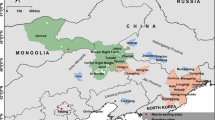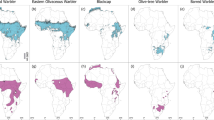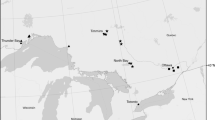Abstract
Woodcock (Scolopax rusticola) are heavily hunted in south-central Europe during the winter and have been the focus of intense management efforts and concern. One of the significant challenges with this and other migratory gamebirds is that they are typically produced in locations other than those where they are primarily harvested. The delineation of origins of harvested Woodcock is important for the identification of appropriate management strategies. Using analysis of stable hydrogen isotope ratios (δ 2H) in feathers of juvenile Woodcock harvested in Spain (2007–2009, n = 802 individuals), we assigned Woodcock origins using a derived Woodcock feather δ 2H isoscape and four potential isotopic regions covering the breeding range. We also used a continuous probability surface approach that used the forest cover available throughout the range as a constraint on origins. The majority (90 %) of Woodcock captured in Spain were assigned to origins in central-eastern Europe (488 individuals, 60 %), and the Baltic region (237 individuals, 30 %). These results were similar to those previously obtained for Woodcock taken in France (although the relative importance of both eastern Europe and Baltic regions of origin was the opposite to those harvested in Spain). This means that a significant portion of the Spanish and French Woodcock bags can be considered as the same management stock, and thus that management of hunter takes in both countries should be coordinated. Additionally, our results provide further evidence suggesting the need for conservation of forests in Eastern Europe, the southern Baltic, the Ukraine, Belarus, and western Russia.
Zusammenfassung
Herkunft von in Spanien erjagten juvenilen Waldschnepfen (Scolopax rusticola), abgeleitet aus der Analyse stabiler Wasserstoffisotope (δ2H) in Federn
Waldschnepfen (Scolopax rusticola) werden in Südeuropa im Winter intensiv bejagt, was Anlass zur Besorgnis gibt, und stehen im Mittelpunkt intensiver Managementbemühungen. Eine der wesentlichen Herausforderungen im Umgang mit dieser Art sowie anderen jagdbaren Zugvögeln besteht darin, dass sie typischerweise an anderen Orten gejagt als „produziert“werden. Eine Beschreibung der Herkunft erjagter Waldschnepfen ist wichtig, um geeignete Managementstrategien zu ermitteln. Mittels einer Analyse der Verhältnisse stabiler Wasserstoffisotope (δ2H) in Federn juveniler in Spanien erjagter Waldschnepfen (2007–2009, n = 802 Individuen) haben wir die Herkunft der Vögel unter Verwendung einer abgeleiteten Waldschnepfen-Feder-δ2H-Isotopenlandschaft sowie vier potenzieller Isotopenregionen, die das Brutgebiet abdecken, zugeordnet. Wir haben außerdem einen kontinuierlichen Wahrscheinlichkeitsoberflächen-Ansatz benutzt, der die Herkunft der Vögel auf der Basis der Waldbedeckung im Brutgebiet einschränkte. Dem Großteil (90 %) der in Spanien gefangenen Waldschnepfen wurde eine Herkunft aus Zentral-Osteuropa (488 Individuen, 60 %) und dem Baltikum (237 Individuen, 30 %) zugeordnet. Diese Ergebnisse ähnelten denen, die zuvor für in Frankreich erjagte Waldschnepfen gewonnen worden waren, wobei dort mehr Individuen aus dem Baltikum und weniger Individuen aus Osteuropa stammten. Dies bedeutet, dass ein erheblicher Anteil der spanischen und französischen Waldschnepfen-Jagdbeute wohl aus demselben Management-Bestand stammt und das Management der Jagdquote in den beiden Ländern koordiniert werden sollte. Außerdem liefern unsere Ergebnisse weitere Hinweise für die Notwendigkeit des Schutzes von Wäldern in Osteuropa, dem südlichen Baltikum, der Ukraine, Weißrussland und Russland.




Similar content being viewed by others
References
Ashley P, Hobson KA, Van Wilgenburg SL, North N, Petrie S (2010) Linking Canadian harvested American black ducks to their natal areas using stable isotope analysis of δD, δ13C, and δ15N. Avian Conserv Ecol 5:7. [online] URL: http://www.ace-eco.org/vol5/iss2/art7/
Bauthian I, Grossmann F, Ferrand Y, Julliard R (2007) Quantifying the origin of woodcock wintering in France. J Wildl Manag 71(3):701–705
BirdLife International (2004) Birds in Europe: population estimates, trends and conservation status. BirdLife International, Wageningen
Bowen GJ, Wassenaar LI, Hobson KA (2005) Global application of stable hydrogen and oxygen isotopes to wildlife forensics. Oecologia 143(3):337–348
Burnham KP, Anderson DR (2002) Multimodel selection and multimodel inference: a practical information theoretic approach. Springer, New York
Ferrand Y, Gossmann F (2009a) La Bécasse des bois. Histoire naturelle.-Saint-Lucien Effet de Lisière, 2009, p 39–40
Ferrand Y, Gossmann F (2009b) Ageing and sexing series 5: ageing and sexing the Eurasian Woodcock Scolopax rusticola. Wader Study Gr Bull 116(2):75–79
Gossmann F, Ferrand Y (2000) Impact of the 1996-97 cold spell on Woodcock in France based on rig recoveries. Fifth European Woodcock Snipe Workshop: 37-39
Gunnarson G, Latorre-Margalef N, Van Wilgenburg SL, Hobson KA, Waldenström J, Elmberg J, Olsen B (2012) Disease dynamics and bird migration-linking Mallards Anas platyrhynchos and influenza A virus in time and space. PLoS ONE 7(4):e35679. doi:10.1371/journal.pone.0035679
Guzmán JL, Ferrand Y, Arroyo B (2010) Origin and migration of woodcock Scolopax rusticola wintering in Spain. Eur J Wildl Res 57(3):647–655
Hijmans RJ, van Etten J (2012) Raster: Geographic analysis and modeling with geographic data. R package version 2.0–12. http://CRAN.R-project.org/package=raster
Hobson KA (2003) Making migratory connections with stable isotopes. In: Berthold P, Gwinner E, Sonnenschein E (eds) Avian migration. Springer, Berlin
Hobson KA, Norris DR (2008) Animal migration: a context for using new techniques and approaches. In: Hobson KA, Wassenaar LI (eds) Tracking animal migration with stable isotopes. Academic, London, pp 1–19
Hobson KA, Wassenaar LI (2008) Tracking animal migration using stable isotopes. Handbook of Terrestrial Ecology Series. Academic/Elsevier, Amsterdam
Hobson KA, Van Wilgenburg SL, Wassenaar LI, Hands H, Johnson WP, O’Meilia M, Kohn S, Taylor P (2006) Using stable hydrogen isotope analysis of feathers to delineate origins of harvested sandhill cranes in the central flyway of North America. Waterbirds 29:137–147
Hobson KA, Wunder MB, Van Wilgenburg SL, Clark RG, Wassenaar LI (2009a) A method for investigating population declines of migratory birds using stable isotopes: origins of harvested lesser scaup in North America. PLoS ONE 4(11):e7915. doi:10.1371/journal.pone.0007915
Hobson KA, Wunder MB, Van Wilgenburg SL, Clark RG, Wassenaar LI (2009b) A method for investigating population declines of migratory birds using stable isotopes: origins of harvested lesser scaup in North America. PLoS ONE 4(11):e7915. doi:10.1371/journal.pone.0007915
Hobson KA, Lormée H, Van Wilgenburg SL, Wassenaar LI, Boutin JM (2009c) Stable isotopes (δD) delineate the origins and migratory connectivity of harvested animals: the case of European woodpigeons. J Appl Ecol 46:572–581
Hobson KA, Van Wilgenburg SL, Wassenaar LI, Larson K (2012) Linking hydrogen (δ2H) isotopes in feathers and precipitation: sources of variance and consequences for assignment to global isoscapes. PLoS ONE 7(4):e35137. doi:10.1371/journal.pone.0035137
Kempeneers P, Sedano F, Seebach L, Strobl P, San-Miguel-Ayanz J (2011) Data fusion of different spatial resolution remote sensing images applied to forest type mapping. IEEE Trans Geosci Remote Sens 49(12):4977–4986
Lucio A, Sáenz de Buruaga M (2000) La Becada en España. Fedenca, Madrid
Päivinen R, Lehikoinen M, Schuck A, Häme T, Väätäinen S, Kennedy P, Folving S (2001) Combining earth observation data and forest statistics. EFI research report 14. European forest institute, Joint Research Centre-European Commission. EUR 19911 EN. 101 p
Peron G, Ferrand Y, Gossmann F et al (2011) Escape migration decisions in Eurasian Woodcocks: insights from survival analyses using large-scale recovery data. Behav Ecol Sociobiol 65:1949–1955
Powell A (2012) Origins and non-breeding ecology of Eurasian woodcock., PhD thesis, University of Oxford, Oxford
R Development Core Team 2012. R: A language and environment for statistical computing, reference index version 2.15.1. R Foundation for Statistical Computing, Vienna, Austria. ISBN 3-900051-07-0. http://www.R-project.org
Royle JA, Rubenstein DR (2004) The role of species abundance in determining the breeding origins of migratory birds using stable isotopes. Ecol Applic 14:1780–1788
Schuck A, Van Brusselen J, Päivinen R, Häme T, Kennedy P,.Folving S (2002) Compilation of a calibrated European forest map derived from NOAA-AVHRR data. European Forest Institute. EFI Internal Report 13
Sillett TS, Holmes RT (2002) Variation in survivorship of a migratory songbird throughout its annual cycle. J Anim Ecol 71:296–308
Snow DW, Perrins CM (1998) The birds of the Western Palearctic vol 1: Non-passerines. Oxford University Press, Oxford
Van Wilgenburg SL, Hobson KA (2011) Combining stable-isotope (δD) and band recovery data to improve probabilistic assignment of migratory birds to origin. Ecol Applic 21:1340–1351
Wassenaar LI, Hobson KA (2003) Comparative equilibration and online technique for determination of non-exchangeable hydrogen of keratins for use in animal migration studies. Isotopes Environmental Health Stud 39:1–7
Wassenaar LI, Hobson KA (2006) stable hydrogen isotope heterogeneity in keratinous materials: mass spectrometry and migratory wildlife tissue sampling strategies. Rapid Comm Mass Spectrom 20:1–6
Webster MS, Marra PP (2005) Importance of understanding migratory connectivity and seasonal interactions. In: Greenberg R, Marra PP (eds) Birds of Two Worlds: The Ecology and Evolution of Migratory Birds. Johns Hopkins University Press, Baltimore, pp 199–209
Acknowledgments
This study was funded by the Comité Interautonómico de Caza y Pesca Continental in Spain and an operating grant to K.A.H. from Environment Canada. The study was carried out within the Framework of the Interregional Study on Woodcock Scolopax rusticola in Spain (Proj. Number 200430E471). We thank A. Powell, A. Hoodless and A. Gossler for providing the Woodcock calibration algorithm. C. Gryba assisted with preparation of samples for isotope analyses which were performed by L. Wassenaar. We thank all ringers of the Woodcock Network CCB, Txepetxa, Keepers of Guipúzcoa, ABN, and hunters of Club de Cazadores de Becada for their participation in the sampling. Finally, Manuel Fernández and Raquel Sánchez collaborated in the selection and subsampling of feathers to be analyzed. The manuscript benefited from the comments of two anonymous reviewers.
Author information
Authors and Affiliations
Corresponding author
Additional information
Communicated by F. Bairlein.
Rights and permissions
About this article
Cite this article
Hobson, K.A., Van Wilgenburg, S.L., Guzmán, J.L. et al. Origins of juvenile Woodcock (Scolopax rusticola) harvested in Spain inferred from stable hydrogen isotope (δ 2H) analyses of feathers. J Ornithol 154, 1087–1094 (2013). https://doi.org/10.1007/s10336-013-0977-9
Received:
Revised:
Accepted:
Published:
Issue Date:
DOI: https://doi.org/10.1007/s10336-013-0977-9




